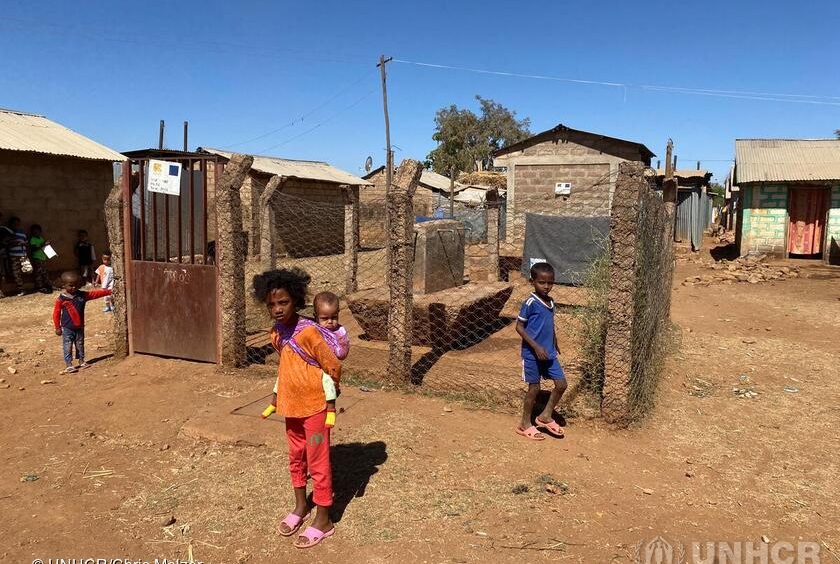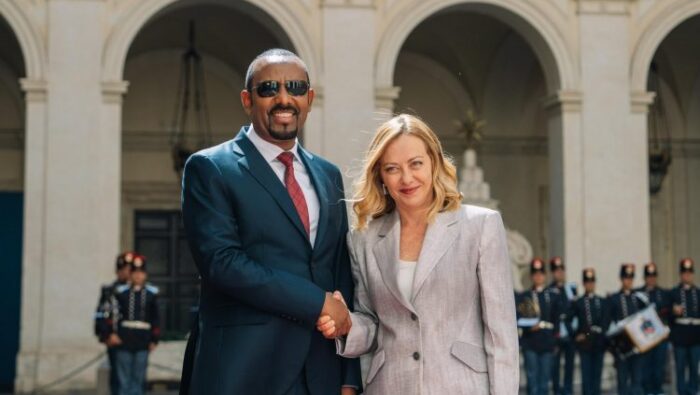Eritreans in the refugee camps of Tigray, Ethiopia.

Eritreans in the refugee camps of Tigray, Ethiopia. Their life during the conflict between the TPLF and the Addis Ababa government that broke out on November 4.
Eritreans in the refugee camps of Tigray, Ethiopia, and their life during the conflict between the TPLF and the Addis Ababa government that broke out on November 4.
The issue of the refugee camps hosting Eritrean refugees is now part of the bigger problem unleashed by the conflict last November between the TPLF against the Addis Ababa government.
It would be helpful to have some facts to explain the historical background. In 1991, Meles Zenawi, leader of the Tigray People’s Liberation Front, the ‘TPLF’, became Prime Minister of the new coalition government. Tigrayans are in the majority in the Ethiopian People’s Revolutionary Democratic Front, the ‘EPRDF’.
The situation remained the same until 2018 when, after months of conflict and violence in the country, there was a call for a political change. Abiy Ahmed, of part Oromo and part Amhara ethnicity, became the Prime Minister. The following year, the EPRDF ethnic federation also changed and it became the Prosperity Party or ‘PP’. The TPLF rejected the PP and left the coalition.
Against the request of the central government to suspend elections due to the dangers posed by Covid, on 9th September 2020, the TPLF held an election in the Tigray region. TPLF militias then launched an assault on military barracks in the Tigray region on 4th November. In response, Abiy Ahmed issued an ultimatum and launched a military assault of his own, with a state of emergency declared in the region for six months. The rest of the country sided with Abiy against the TPLF faction.
The relatively short conflict caused and exacerbated two humanitarian problems. On the one hand, 60,000 Tigrayans were displaced from their homes to refugee camps in Sudan. On the other hand, it affected 96,000 Eritreans who had been residing in Tigrinyan camps for over ten years. In both cases, UNHCR is the United Nations agency responsible for dealing with it.
This caused the UNHCR high commissioner Filippo Grandi to travel to Ethiopia last week to investigate the problem of Eritreans in refugee camps in Tigray and see the conditions for himself. He visited the Mai Aini camp accompanied by representatives of ARRA, the Agency for Refugee and Returnee Affairs.
Mr Grandi had already expressed his concern for their fate on 14th January in a statement to the press. While reassuring news arrived from the Mai Aini camp (which is home to about 20,000 Eritreans) and Adi Harush (which has 30,000 living there), nothing was known about the Hitsats and Shimelba camps. The first of these two is a recently built camp hosting about 20,000 Eritreans, the second is a camp for refugees who have been living in the area for a long time. According to a rough estimate, there could be around 6,000.
In recent days, the UN has announced the disappearance of 20,000 Eritrean refugees who lived in these two camps. Twenty thousand people, including women and children, vanished. No one has seen them leaving the camps, and no one knows where they are now.
This is the reason why UNHCR sounded the alarm. Filippo Grandi stated that he is concerned about the “well-being and safety” of Eritrean refugees. Not only that, but the High Commissioner was also concerned about the “reliable and first-hand” reports of “serious and painful violations of human rights, including killings, targeted abductions and forced repatriation of refugees to Eritrea”. He explained that this information seemed to be corroborated by the open-source satellite images of the two camps mentioned, showing signs of fire and destruction.
What was burned? According to the aforementioned source, a food warehouse, a health facility, a school, and some other buildings.
Who started the fire, if indeed it was arson? Perhaps the TPLF militias, to stock up on food in an area where everything is lacking? With the camp in flames, what were the Eritrean refugees to do? Save themselves and flee, or risk their lives by staying?
According to UNHCR, they were forcibly returned to their homeland.
It was announced to the press that it was feared that Eritrea had kidnapped young people to forcibly repatriate them.
Media reports picked up on this and added that Eritrean refugees are now in jail.
The Eritrean Information Minister denied it. He stated in a tweet that no Eritrean had been forcibly repatriated, neither now nor ever. However, the accusation in the media did not go away. It has overshadowed the news about the raids by TPLF militias.
Why would Eritrea in these circumstances force the refugees from the Tigray camps back to their homeland? That would mean that Eritrea, after closing its land, sky and sea borders, imposing a severe lockdown on the country, creating centres where citizens returning from abroad are required to have test swabs, imposing a quarantine, and, after all of this, that they decided to grab twenty-thousand refugees many of whom were probably positive for Covid-19.
However, on 27th January the UNHCR spokesman for Ethiopia, Chris Meltzer, said something different.
According to him, there was no kidnapping and no forced deportation of Eritreans from Tigray refugee camps. He could confirm this as he had visited the refugee camps of Mai Aini and Adi Harush along with a UNHCR and ARRA on Saturday 23rd January. The Eritreans were still there.
Melzer declared to the press that the charge of kidnapping and forced repatriation was false.
He added that food distribution had now also resumed, guaranteed by the United Nations World Food Program. Fortunately, refugees were not dying of hunger and the situation was improving.
In the two camps of Mai Aini and Adi Harush, which welcome about half of the Eritrean refugees present in Ethiopia, conditions were good.
A representative of the Italian organisation Sant’Egidio was contacted in January about the situation in the camps. He explained that “although the news is meagre and contradictory, the conflict did not take place near the four camps, so Eritrean refugees should be safe. Despite the war, it is likely that the camps have not been bombed ”.
“The problem in the camps”, he continued, “is the supply of food, as is the case in all of Tigray.” Furthermore, after the outbreak of the conflict between the TPLF and the federal government, the agencies that were present (UNHCR and NGOs) withdrew all their staff.
The UNHCR’s Shirè office, its headquarters in Tigray, was immediately evacuated.
This is the reason why, as the representative of Sant’Egidio commented: “We know that many refugees have fled, trying to get to safety and going to Addis Ababa”.
Perhaps many of those twenty thousand now missing from the UNHCR headcount are among them.
They could have fled for fear of attacks on the camps by the TPLF militias, who might have sacked and burned the camps where the food reserves were stored.
The interim mayor of Mekallè addressed the looting after a meeting with the population. He told a local broadcaster that there have been many robberies in the area, in private homes, offices and at municipal facilities. He explained that in Mekallè looting and destruction were carried out not by outsiders but by people from the community. The mayor concluded that this was a painful situation on which the city will have to reflect.
Regarding the refugee camps, it is useful to remember that they are managed by the UNHCR and ARRA, as the representative of Sant’Egidio explains. That means that the Ethiopian state is a party to the dispute. This is important because until 2018, before the arrival of Prime Minister Abiy Ahmed the camps for Eritrean refugees were organised ghettos. It is said that human trafficking sometimes started in the camps.
The Eritreans could not get out, at least not legally. They could not work and were not entitled to an identity document. There was no official register. The situation changed in 2019 when the reform introduced by the government of Prime Minister Abiy decided to bring Eritrean refugees into the social sphere. Since then, refugees have had the right to leave the camps to work and study, or for medical examinations and family reasons
As a result, when the state of emergency was declared, many from the camps fled towards Addis Ababa. How many have made it and how many have been brought back? These are questions without answers for the time being.
“We have no reports”, said the representative of Sant’Egidio, “that members of the Eritrean army have entered the refugee camps in order to take refugees to Eritrea”.
The situation was also confirmed by phone on 7th January by Carlotta Sami of the UNHCR. She explained that the news regarding the conditions of the camps came from the refugees themselves, who spoke of “unidentifiable armed people who had attacked the camps”.
Taking a step back, why are there four Eritrean camps on the border with Ethiopia, in the Tigray region? This was partly explained by Filippo Grandi during the recent conference in Addis Ababa. Ethiopia, he said, is one of the countries that has hosted the most refugees for decades, some 900,000. A commitment, he added, for which it deserves credit.
There is also another reason why there are four camps for Eritreans and of the two new ones Adi Harush was expanded in 2012, and Hitsats opened in 2013.
In 2012, during a speech at the Clinton Foundation, the then President of the United States Barack Obama said, referring to Eritrea, that he wanted to help the organisations that were helping young people escape the country. The goal, with the backing of Ethiopia governed by Meles Zenawi, was to depopulate Eritrea and bring about a change of government.
The plan continued for the next two years and the Special Rapporteur for Eritrea, Sheila Keetharuthm, wrote to the United Nations Security Council that “rates of Eritrean emigration are one of the highest in relation to the overall population”, so much so that more room had to be created for Eritrean refugees arriving in Tigray.
For a young Eritrean who wants to emigrate to Europe or America, without the possibility of a visa, the easiest way is to go through Tigray. They will stay in the camps for a while, before embarking from Libya to Italy and then continuing further into Europe.
Before 2018, those fleeing Eritrea handed themselves over to the Ethiopian military in Tigray. They were then sent to the Endabaguna registration centre run by the UNHCR, and assigned a place in a camp where Tigrinya is spoken, like Shimelba, Mai Aini, Adi Harush and Hitsats. All are located in Tigray.
Following the meeting between the Ethiopian president Sahle-Work Zewde and Filippo Grandi, the state agency Fana wrote a short note offering assurances that basic necessities and essential services had resumed in the refugee camps in Tigray. There was no mention of the UNHCR’s fears of possible forced returns.
The newspaper Avvenire, instead, maintained that the forced returns were a fact
The Catholic paper reported testimonies of Eritrean refugees from Mai Aini, the camp visited by the UNHCR and ARRA. Here, said an anonymous source, “Eritrean troops have ordered refugees to march towards Shiraro, near the border. The exodus lasted four days, from 7 to 11 January. Women, the elderly and children had to also walk. In Shiraro (ed, a town on the border between Eritrea and Ethiopia) the refugees were transported to temporary detention centres in three Eritrean locations, Badme (disputed with Ethiopia), Shilalo and Tokombia. Their traces have been lost ”.
Could it be that the people to whom Avvenire refers are those twenty thousand of which news has reached the UNHCR? Were they, children and women included, forced to march to the Gash Barka region? They would have departed from Mai Aini, which is not the camp where the fires occurred, but one where the situation was better. Twenty thousand people escaping from Mai Aini compares to a total population in the camp of about the same number before the conflict. Something is wrong. If twenty thousand people had left, the UNHCR would have visited an empty camp, saying instead that everything was fine there.
Finally, it is worth mentioning that as far as Avvenire knows, Badme is no longer disputed but has been Eritrean since 2018. This had already been settled in 2002 with the Algiers Agreement, but Ethiopia never really accepted it. It was Abiy Ahmed himself who signed the peace agreement in Asmara immediately after his inauguration. One of the causes of the clash between the TPLF and the federal government is the peace between Abiy Ahmed and Isaias Afwerki.
A peace that some do not accept.






Lascia un commento